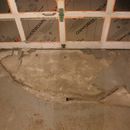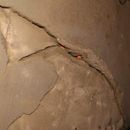Repair for collapsed garage floor
Hi,
I bought a house a few years ago (construction – 1968). I noticed a crack in the garage that had been patched with new concrete. The patch was now falling apart, so I decided to dig it out to make a new repair. Lo and behold, I found out that the fix was attempting to level a part of the garage floor that had collapse (see picture)
The crack is very large and I can touch the soil under. There seems to be a void under the slab that hasn’t collapsed. I think the soil might have eroded as a result of chipmunks digging in that part of the foundation and the old owner who discharge downspout water directly at the foundation wall.
To repair this, I’m thinking of filling the large crack with sand all the way to 1/2 inch of the base slab. Then, I will recoat with sand mixed cement. I think my repair should be better than the last one because the previous repair did not fill the large crack and merely “coated” the crack with concrete.
Opinions?
Thanks a million!
GBA Detail Library
A collection of one thousand construction details organized by climate and house part











Replies
Just a guess, but I'd look into cutting out the cracked sections, drill into the exposed vertical edges and epoxy in rebar, add pea gravel and then pour new concrete.
Mud jacking is the right way to fill the voids and prevent further collapse. I'd be concern that sand would flow out similar to the soil. While I've not done it, I've seen several guys lift the slabs then use canned spray foam to fill the void.
There are actually franchise guys that use "spray foam jacking" now as well. Do it the same way as mud jacking. Drill holes in existing slab and pump the juice to her.
But can you drive on it? I've not seen anything definitive about DIY mud jacking with Great Stuff foam in a can.
But if the piece that collapsed is now stable and the main slab doesn't seem impacted by void (I parked my car inside the garage with now issue), wouldn't making a crack & surface repair with concrete be enough to fix the issue?
Thanks for all the great ideas!
Marc,
I like #1 reply from Jon R. That’s the best way in my opinion, however, your soil beneath the slab is more likely the culprit. The soil IS your foundation and if your foundation is weak, the concrete will likely crack again. You can create a thickened slabs along with proper reinforcing bar to span bad soil, but that’s beyond my pay grade. No concrete person will guarantee no cracks but the good ones will be the ones who have been in business a long time. A proper concrete mix is important too. Happy pour.
I have to work with county road commissions at work to do restoration after doing utility projects. The road commissions are VERY specific about what to put under the road surface, and the information is publicly available. Since your garage floor has similar requirements to a roadway, just with a thinner slab, I'd use similar materials.
There is a material known as "flowable backfill" that would be good for this project. We use it at work after coring a large access hole in a roadway to expose utilities we're crossing. The material is designed to fill the hole, settle quickly, and be easily compacted. New concrete can then be poured over the top. If you can expose the entire void in your floor (no overhanging concrete on the edges), fill the hole with flowable backfill, compact it, then pour new concrete over the top. Drilling some short sections of rerod into the surrounding slab edges will help to keep the new piece aligned with the existing slab so that you don't have issues in the future.
I'd check if you have any water erosion issues too, and fix those issues first. You don't want to make this repair just to have it fail again the same way. Fix the cause of the problem first, then fix the problem itself.
Bill
I would definitely cut out that section, redo what is underneath and pour a new patch.
It is pretty common to find things like wood under garage slabs that is now decomposed leaving a void.
I say the best fix is to break up the old slab haul it away fill the hole and install a new slab.
Any attempt at repair will show and always look like it was repair forever. In 5 years the new slab will have age and gotten a few stains and most people will assume it is original.
Walta